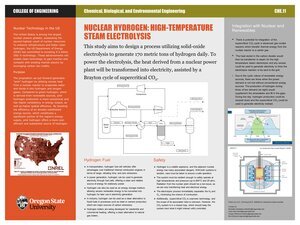
College of Engineering Unit:
The primary deliverable of the design project is to design a plant capable of producing 170 metric tons of hydrogen per day via high-temperature steam electrolysis. The plant will be designed to utilize a prescribed pathway, either Cu-Cl thermochemical cycle or high-temperature electrolysis with supercritical CO2, as determined through analysis and modeling using appropriate software such as Aspen Plus. The design will focus on the process steps following the reactor-produced steam and electricity.
The CuCl2 cycle is a four-step process that operates at low temperatures and includes hydrolysis, Cu2OCl2 decomposition, electrolysis, and drying. It can be optimized for different applications and adjusted quickly as needed, allowing for a flexible response to changes in hydrogen demand. In contrast, the HTSE cycle produces gaseous hydrogen through electrolysis of steam at elevated temperatures, typically 800-1000°C, and requires a significant amount of energy to maintain the high temperature. Due to the slower response time to changes in demand, the HTSE cycle is more suitable for continuous hydrogen production. While the CuCl2 cycle is better suited for flexible responses, the choice between the two cycles depends on the specific needs and conditions of use.